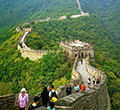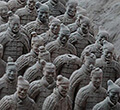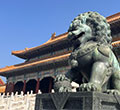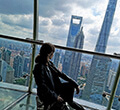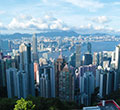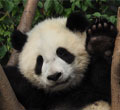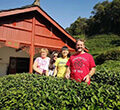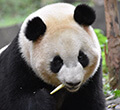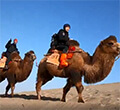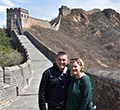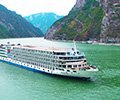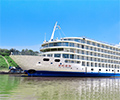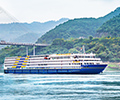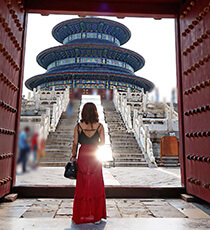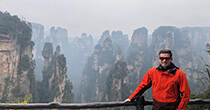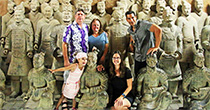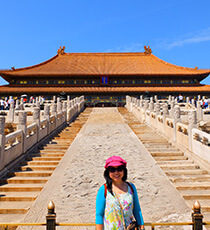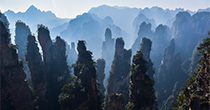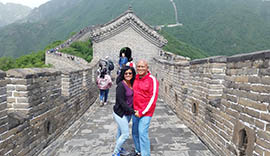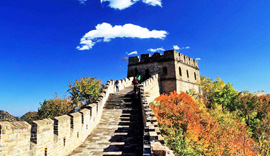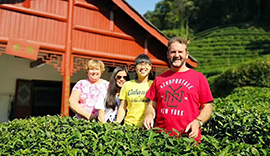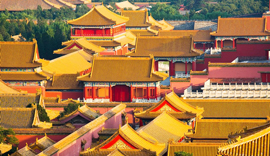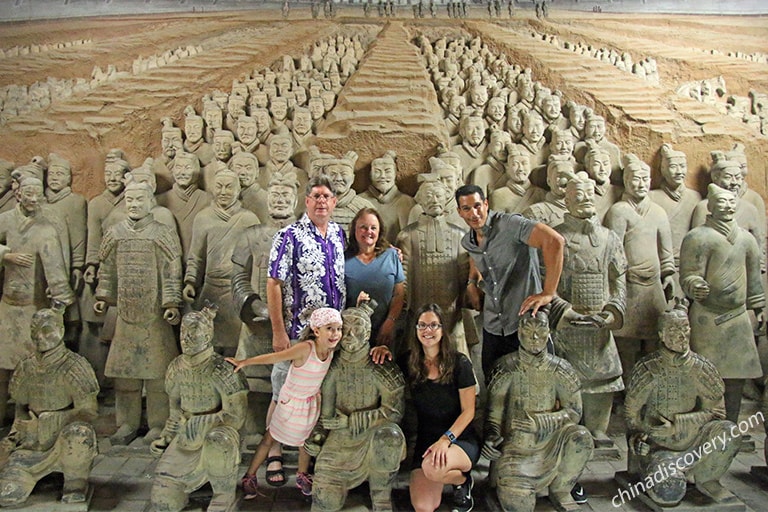Sweet Couple's 21-Day Northern China Exploration
-- Roger and Christine's 21 Happy Days in Beijing, Xian, Luoyang and Other 6 Cities in Northern China
-
 Roger & Christine (UK)
Roger & Christine (UK)
-
Departure Date2018.10.13
-
Travel Length21 Days
-
Travel ThemeNature, Culture, Religion, Couple
-
Group Size2
-
Travel RouteBeijing - Datong - Mount Wutai - Pingyao - Xian - Luoyang - Jinan - Taian - Qufu - Beijing - Chengde - Beijing
-
HighlightsForbidden City, Temple of Heaven, Yungang Grottoes, Hanging Temple, Mount Wutai, Pingyao Ancient City, Terracotta Warriors, Muslim Quarter, Shaolin Temple, Longmen Grottoes, Daming Lake, Baotu Spring, Mount Tai, Temple of Confucius, Jinshanling Great Wall, Chengde Summer Resort
China - Beijing - 12-16th October 2018
Chris and I are on a train from Beijing to Datong. We are in a sleeper coach, alongside a party of friends and family from Strasbourg, who organise a joint foreign holiday every year. We arrived in Beijing on the 13th. We are staying in a small hotel in Happy Dragon Alley. The ‘alley’ is a “hutong”, a lane just wide enough to drive a car down in an area of traditional single storied, grey brick, small houses. What has impressed us most are the crowds. Beginning on the first afternoon when we walked from our hutong to another that has been transformed into a street of gift shops and cafes (South Luogu Alley). As it was a Sunday it was especially busy, with mostly under 30’s residents of Beijing enjoying their free time. The city is home to 24 million and most look well fed, well dressed, and have money to spend.

Rickshaws in Beijing Hutong, Photo Shared by Roger
By the time we reached the medieval “Drum” and “Bell” towers it was 5 pm and a grey dusk was gathering. We walked back along the canalised Yu river, which has been transformed into an attractive pedestrian route, furnished with fountains with coloured lights along the river bed. Central Beijing is “greener” than I expected, with lakes and tree lined boulevards, and even trees along some hutongs. There are ancient trees in the garden of the Forbidden City and the courtyard of the Confucius Temple. And new trees massed in front of new buildings. The Ming Emperors believed beauty was inseparable from nature. This view has survived the upheavals of the last century.
The shopping street at the end of our lane has many small cafes where we can eat well and cheaply. Fortunately several have pictures of their dishes that we can point at. In the morning many sell steamed buns, filled with minced pork, served with chilli paste and dilute soy sauce. Several have the steamer just outside the doorway, so it is easy to indicate you want some. I have a bowl of soya broth too, as do many local customers. This is very bland so Chris hates it.
The day after our arrival our pre-arranged private tour began with a visit to Tian’anmen Square with our guide Kai. He is 42 and Beijing born. As a child he had played in the square. It is a vast area created by Mao Tse Tong ordering the demolition of the Imperial administration buildings that had stood in front of the Forbidden City. The square was where people of all ages came to play games and relax. That is until the suppression of the student protest here in 1989. Since then everyone has to pass through security checks to enter the square, and it is closed at night. Kai added that at least 10 per cent of the several thousand present on the square this morning were plain clothed policemen and policewomen. There were a lot more than a thousand queuing to see Mao, embalmed in his mausoleum. His image looks out from a huge banner hung from the balcony of the hall that stands at the entry to the Forbidden City, where he proclaimed the founding of the People’s Republic in 1949. A fitting location considering he became in effect an Emperor, as unchallengeable as the “Sons of Heaven” had been.
At 72 hectares the area of the Forbidden City is even greater than Tian’anmen Square. It contains 980 buildings. But you do not get to see into any, even the most important ceremonial halls, such as the Hall of Supreme Harmony. It stands some 30 meters above the level of the surrounding square. It is the ceremonial center of imperial power, and the largest surviving wooden structure in China. Originally built in the 15th century it burnt down repeatedly and what one sees today is 17th century. These halls are empty anyway, or to be exact contain only a gilded throne. But the reason for the prohibition is that the buildings would simply be worn away by the passage of the 16 million visitors the City receives each year. Once inside the City one moves through it in a flowing river of visitors. Overwhelmingly Chinese from other parts of China. The City is impressive for its scale, its vast courtyards and central platform, rather than the individual buildings, which are all single story. For me the best part was the garden at the end, which comprises trees and strange, grotesque, rock formations mounted on stands. This is such a contrast to the western taste for classical statues. They exemplify the Chinese belief in art in nature.
A short drive away stands the Temple of Heaven, a large circular pagoda on an artificial hill where the Emperor gave offerings to the God of Heaven to ensure good harvests. Thereby demonstrating to the public his essentially protective function and his legitimacy as “Son of Heaven” (a living god, ruler of the world, responsible for the prosperity and security of his people). Here the crowds were less but it remained impossible to take any photos without several people in them. We ended our day in the Capital Museum, a striking modern building. The high point there for us was the collection of exquisite porcelain.
The following day we were encouraged by Kai to start at 8 am, due to the distance we had to drive. So we got up at 6.30 and emerging into our lane in search of breakfast, found that the working day was already started. Children were waiting to get into the primary school on our lane at 7.30 when we returned. The school day starts at 7.45. We visited the Botanical Garden and the Summer Palace, an hours drive from the city centre. The grounds of both are very large and one could have spent a day at each. At the Botanical Garden there was a celebration of chrysanthemums, with beds of chrysanthemums in blocks of different colours and hundreds of single flower heads displayed on tables along a central path, with poems from many renowned poets on the subject of these flowers on boards behind them. Kai translated a couple, one that was melancholic and a second that found joy in the flower’s appearance in autumn. There is also a wonderful collection of bonsai, which includes dwarf trees (up to 3 metres tall). One of these is a 1300 year old Gingko biloba. At the crabapple garden there are hundreds of varieties planted on rising ground giving pleasing views of misty hills beyond the garden.

Colored Glaze Archway of Wofo Temple at Beijing Botanical Garden, Photo Shared by Roger
At the Summer Palace it was back to sharing the experience with thousands of others. The Palace is as in the Forbidden City a succession of courtyards of single story buildings. The palace comprises three courtyards. The first has the smallest area and was the last Emperor’s palace. Next was the palace of the Empress for whom he had no affection, but who was a relative of his aunt. And the final courtyard was the biggest and was the palace of his aunt, Dowager Cixi, who who had the Emperor under her thumb. She had the long covered walk built beside the large lake that comprises the greater part of the grounds. She also had the “Tower of Buddist Incense” rebuilt following its destruction by European soldiers in the second Opium War. It was re-opened on her 60th birthday. Co-incidentally it rises from a stone platform 60 metres above the lake. The view from its terrace over the lake is commanding. But it was so misty this afternoon, to the point of drizzling, that we could barely see the far side of the lake and its graceful 17 arched bridge. But, so we have learnt, mist is a positive element in Chinese aesthetics, because having something suggested, left too be interpreted by the viewer, is part of the art of appreciation. The stone ‘sculptures’ are selected for this quality too. There is a good collection of these in the park. Some look like mountains, some like clouds, others mythical beasts. It is all about using your imagination!
Today has been more relaxed, with just visits to the Imperial Academy (which includes the Temple of Confucius) and the Tibetan Buddhist Lamas Temple. At the former, in the original buildings of the college, one learns about the education system that supplied competent and cohesive civil servants for centuries, and thereby sustained China as a unified state. It was an immensely important legacy from Confucius’s teaching. But it still remains hard to understand how admiration for the man transformed him into an object of worship. However, there are a number of examples of similar elevation. The God of war for example was a real life general who became famous for both his military skill and his loyalty. Also, there is the tradition of ancestor worship, which has been continuously part of Han culture for thousands of years. Perhaps it is about immense respect for these individuals, respect to the point of attributing super powers to them.
In front of the temple a group of primary school children had been marshalled in rows. They stood very erect as their teacher, in Qing era dress, told them Confucius’s instructors on good behaviour. Kevin, our guide for today told us they were a group visiting Beijing from elsewhere in China. And added that it costs a lot of money to send your child on such a trip.
From the Imperial Academy we walked to the nearby Lama Temple (Yonghegong). Kevin is a practicing Buddhist, as are his parents. But not of the Tibetan Lama branch. He said he disagrees with their doctrine that places the enlightenment of the Lama above that of Shakyamuni Buddha. Even so, he collected a bundle of incense sticks and gave us three each to burn at each of the three of temples in successive courtyards. He knelt to bow three times in each place. He explained he was praying his wife will become pregnant with their first child, which he hopes will be a son. The big surprise of this temple is in the main hall of the fourth and final courtyard. It contains a 28 metre tall sculpture of Maitreya, a Buddha to come. The huge golden standing figure, with swirling robes, was carved from a single sandalwood tree trunk. It was a gift from the Dali Lama to Emperor Qianlong. It is in the Guinness Book of Records.
A side hall contains an exhibition covering the history of the sect. There is great emphasis on how it supported the unity of the state (acting as a bridge linking Tibetans and Mongolians to the Imperial administration). This connection was especially used by Emperor Qianlong of the Qing dynasty. He conquered Tibet and Inner Mongolia (in the middle of the 18th century). He recognised the spiritual authority of the lamas, in return for their accepting his temporal authority. He also re-instated the Yonghegong as the seat of Tibetan Buddhism in Beijing, under his control. Since the creation of the People’s Republic, according to this exhibition, the sect has been reinvigorated by the principles of ‘democracy’ and ‘socialism’. And is again fostering the unity of the homeland. What has been revived is the old imperial idea of the partnership of temporal and religious authority, with the temporal having the final prerogative. There was recognition that from 1966 there had been a ten year interruption to this “going forward together “. But the term ‘Cultural Revolution’ was not used, nor was there any mention of what happened. And, of course, there was no discussion of the Dalai Lama, who leads the “Red Hat” sect of Tibetan Buddhists, and who has long argued for greater autonomy for Tibet.
China - Datong - 16-17th October 2018
We had arrived late in the evening, around 10 pm. We had eaten nothing on the train, a mistake because most restaurants in China are closed by 9 pm. It was also cold, and this made us feel all the hungrier. The only option left was a Kentucky Fried Chicken cafe, ten minutes walk away through the empty streets (silent apart from one rebellious youth racing past on his rev’ed up motorbike). This was certainly our worst meal in China. Even instant “pot noodles” are tastier.
We awoke to a beautiful morning. A chill to the air, and trees gathering autumn colours, and a wonderful clear blue sky “Datong blue” said Meggie, our guide. Such a relief after the gloomy grey sky of Beijing. But it is quite a new phenomena, because until recently Datong was known as “coal city”. However, to reduce air pollution bans on the coal for domestic purposes have been introduced.
Our guide is a lady of 42 who has visited Datong’s twin city in the UK, Bury. Her name is Meggi. Her English is very fluent and she is well informed. She is interested in the history of the places we visit and very knowledgeable too. But she can discuss any subject we care to raise, and appears to enjoy conversation with us. She is very good company. In the winter, when there is no work for a guide, she works as a translator and writes literature for tourists. Meggi is single and lives with her mother in Datong.
Our visit begins at the fabulous Nine Dragon Screen. It is over 600 years old and stand opposite what would have been the entrance to Zhu Gui’s palace. It is the oldest and biggest such screen in China (45×8 metres). These types of walls were designed to protect palaces from evil spirits and negative energy. It is amazing it survived. Perhaps the beauty of its glazed tiles, its golden dragons in bas-relief, had such a positive impression that no one wished it harm.

Nine Dragon Screen in Datong, Photo Shared by Roger
Nearby is Huayan Temple. It is famous for its well preserved 12th century architecture. It had the good fortune to be turned into a museum during the Cultural Revolution and was protected from damage. I should remember it better than I do, but today was so full of experiences, not to mention the biggest lunch ever. Also the problem with temples is that photography within the buildings is forbidden, so one has to rely on frail memory. Huayan has a massive main hall, built on a 4 metre high platform. Indeed, it is the largest extant hall from the period. Its inner walls are richly decorated with frescoes, which makes it especially remarkable. But what sticks in my mind is the unusual and attractive wooden pagoda.
Unforgettable for their hugeness are the walls surrounding the old city. What one sees today date from the 14th century, when prince Zhu Gui, the 13th son of the first Ming Emperor, transformed Datong into a military city guarding the border with Mongolia. The walls are 14 metres high and wide enough for five or six cars abreast. Beyond the walls lies a moat 5 metres deep and 10 metres wide. The entry gates have multiple watch towers and inner yards. Amazingly the city was sacked in 1649, then rebuilt in 1652. These seemingly over specified battlements were restored in the last 10 years to mint condition. The ancient city within is likewise being rebuilt, in modern materials, to its Ming appearance. The existing mixture of nineteenth century courtyard houses and mid-twentieth century low rise apartment blocks are being systematically demolished. All of this has required the relocation of 200,000 people. Our hotel is in this new-old quarter, which is picturesque enough but lacking people. From the walls you cannot escape the sight of the modern city of towering buildings on every side.
Last in the old city was Shanhua Monastery. It too has a very large Mahavira temple, also with murals albeit much damaged. At 40.5 metres by 25 metres it is a little smaller than the one in Huayan. However, it is older, built in the 11th century. The are multiple courtyards and many buildings in the monastery and unusual roofed walkways alongside miniature canals. I recall multiple roofs of shining glazed tiles with flamboyant upturned corners. And a quaint tower which provides an excellent view of the progress of the demolition and rebuilding of the old city. Named the Puxian Pavilion it was destroyed in the war with the Japanese and rebuilt in 1953, but looking at it you would think it was centuries old. Nothing is as it seems at first sight! The grounds are beautiful. Pplanted with many small trees, the leaves of which have turned delightful shades of yellow and red.
Mostly our lunches are included in our tour. We tell all our guides we want to eat in the kind of restaurants they would go to, and definitely not ones serving western style food, which are full of European and American tourists. One reason we particularly liked Meggi was that she volunteered to eat with us. Our driver always joined us too, and Meggi would pick dishes for us all to share. This way we got to taste far more dishes than eating on our own. On this our first meal together Meggi selected 9 dishes! It was a lot more than we could all eat, so there was food left at the end. But Meggi said that was a good thing, because it shows we all had had enough. We said we had been brought up to “waste not, want not”, which is to say we were happy if our guests licked their plates clean, because it showed they enjoyed the food. But, countered Meggi, that would embarrass a Chinese host, because it would suggest they had not provided enough food, a failing which the Chinese regard as greatest sin in catering. We compromised. From now on it would be only 7 dishes for lunch!
The afternoon was devoted to the Yungang Grottoes; 51,000 figures, mostly Buddhas, cut from a rock face, within 53 shallow caves. Most are very small, surrounding large figures several times life size, which are almost freestanding. Many of the carvings are over 1000 years old, the oldest date from the 5th century. The most recent were carved in the Qing dynasty, just a few centuries ago, by which time the statues had become stiff, formulaic. There were lots that we admired for their life like features and blissful smiles. In some of the caves the entire interior was carved and coloured. The detail and the painstaking effort taken to produce it was jaw dropping. Golden afternoon light shining on the cliff face added a romantic hue to the setting. It is now surrounded by quiet country side. But when the carvings were made the cliff overlooked a busy road.

Cave No.20, Highlight of Yungang Grottoes, Photo Shared by Roger
Tonight I finally installed VPN software that can cut through the internet wall the Chinese government has created to block all Google products. Our personal email accounts are Google ones. I had installed a VPN app prior to coming to China. But it proved to be one that is blocked. Consequently, I have had much difficulty finding one here that does work and downloading it. Interestingly there is one paid for VPN, much advertised on the internet, that the Chinese government turns a blind eye to. Is this a subtle way to promote capitalism?
China - Datong to Wutaishan - 18th October 2018
We are driving across a great plain on motorways and four lane highways. It is a beautiful day, golden sun and clear blue sky. All the roads are lined with trees, 4 to 20 rows deep; poplars, birch, cypress, summac with red leaves and others. We stopped at Yingxian wooden pagoda (Fogong Temple). It is the oldest wooden pagoda in China, built 1056 CE. Constructed by Emperor Daozong on his grandmother’s birth place. It is built of pine, with 57 kinds of joints. Boards hang from its balconies. Donated by rich and famous visiters over the centuries. These praise the building, which is now leaning. Consequently visits are restricted to the ground floor. Here is a large seated Buddha, the Buddha of mercy. The Buddha has a wispy moustache and beard, which the Emperor from the nomadic Liao would have worn. The pagoda was renowned for holding a tooth of the Buddha. Amazingly a tooth was recently found in a chamber discovered beneath the building. It was also a watch tower. Wars were frequent in this border area, which is a large plain. It is surprising the pagoda survived. The rest of the temple was burnt down during the war ending the Ming dynasty. Holes were smashed into the Buddha on the ground floor during the Cultural Revolution. But again the building was left intact.

Yingxian Wooden Pagoda at Fogong Temple, Photo Shared by Roger
Next stop was the Hanging (Xuankong) Temple. It is located at the foot of Mount Heng, the northernmost of the five Taoist holy mountains. The temple dates from the 5th century, but has been repeatedly modified up to the Qing dynasty. It is breathtaking both from a distance and close too, because it defies gravity. It certainly lives up to its name. Comprising several small temples in a line, they are built along an invisibly narrow rock shelf 75 metres up vast sheer rock face (originally 100 metres above the foaming river at its base). The temples are also supported on beams driven into the rock. Ours was quiet day in terms of visitor numbers. But we still formed a continuous line along the one way route, up and down narrow steps and over the tiny balconies from which one peers into the small cave like shrines, or looks over the insubstantial balustrades to the dizzying drop below. Uniquely the shrines contain statues of the Buddha, Taoist gods and Confucius together. In December 2010 Xuankong Temple was listed byTime magazine as one of the world’s top ten most odd dangerous buildings. Despite the crowds it is amazing. Indeed with the buildings crowded with people, it is a testament to their builders that the weight of tourists does not pull the temples off the rock face.

Hanging Temple on the Cliffs of Mt. Hengshan, Photo Shared by Roger
China - Pingyao - 19th-21st October 2018
Pingyao’s ancient city is a gem. During the Qing dynasty it developed through trade and ultimately banking to become the wealthiest city in China. But in the chaos following the collapse of the Imperial Government, the banks failed, the city’s wealth disappeared and the city’s development ceased. Consequently, when modern tourism began in the 1980’s Pingyao was rediscovered as one of the best preserved historic cities. It is now surrounded by a modern city of skyscrapers. But the old city still sits within its encircling walls. The houses are of a uniform and harmonious style, one or two storied, built around one or more courtyards. The windows look into the courtyards. The walls are grey brick and the tiled roofs are grey too. But the colour is not oppressive. It is simply neutral. Also, the shop fronts are predominately wood and glass, with ornamental boards of intricate fretwork above the windows and doorways; elegant and distinctly Chinese.

Pingyao Ancient City in Shanxi Province, Photo Shared by Roger
We had a little difficulty finding our lodging because it was down an alley. But a local pointed it out. It is a private two story courtyard house, in which the owners live. A wooden balcony provides access to the upper rooms, each of which has a thick red curtain over the door. The combination of the brown wood and the red is very attractive. The lady host was very friendly, and her son, who appeared shortly, too. He spoke some English and marked up a map for us of places of interest. The room was small, but ensuite and very clean. All we wanted, and only £15 for bed and breakfast. We ate dinner there too, and the dishes were as good as the restaurants we have eaten in. We then went out to explore. The principal streets were busy with Chinese tourists and the gift shops, restaurants and bars a blaze of lights. We looked into the several antique shops. I would like one of the mounted pieces of marble that were ornaments in wealthier homes. The linear patterns in the grey and white marble suggest the outlines of mountains. There were several good ones, but they are expensive at over £100. So they are off our shopping list! By 9.30 pm the crowds were thinning, and shops and restaurants closing. By 10 pm all is quiet. The Chinese are early to bed and early to rise.
We ate our Chinese breakfast at 7.45, cooked by our hostess. There appears little difference between breakfast and lunch in terms of the dishes served. But I don’t mind. It is all tasty and I put on weight during our holiday. Our guide took us to the 3 “must see” sites. The city walls, the Confucius Temple and the first bank in China. The city walls are impressive, although not as excessively large as Datong’s. They are made of earth, faced with brick on the outer walls. Presumably the earth is the loess that the surrounding countryside is composed of. The evidence of sheets against parts of the inner wall indicated it requires regular maintenance. From the walls one can see that the ornate City Tower and the Literary Tower of the Confucius Temple are the only buildings rising above the rooftops of the houses. The Confucius Temple has the usual architecture of single story halls around courtyards planted with trees. But different here is the line of stone animals alongside the central path; pig, bull, rat, rabbit, fox, dragon and cobra.
We visited the first bank after the now regular large lunch. A mere seven dishes this time. What we particularly enjoy is that Meggi eats with us (and Mr Wang the driver). So we get a better and larger choice of dishes than we could manage on our own. The bank has little in it but Meggi’s explanation was fascinating. It was set up by a successful fabric dyer who had branches in several cities. He recognised there would be a market for enabling merchants to deposit money at one location, such as their home town, and withdraw an amount in another location where they are conducting business. All the worry of transporting money would be removed. This is the service the first bank was set up to provide, for a fixed fee. It proved so popular that other banks quickly followed. Interestingly its operation entirely depended on the reliability of the post, to convey notifications of deposits and withdraws. It also required anti-counterfeiting measures to prevent copies of receipts being presented. One innovation by the first bank was the invention of the watermark on paper.
We then had 2 hours free time, in which we visited the City God Temple, which had a brightly painted, wooden diorama of hell, including disembowelling, the mountain of swords, people being sawn in half, and boiled, and ground in a mill, and given a red hot copper ball to swallow. We have all been warned! We looked around another bank, which had rooms furnished in period style and an underground silver vault. We also looked around what called itself “The first armed escort museum”. Very appropriate considering the banking activities of the city. We also managed to squeeze in buying a lacquer box and two pictures made by cutting out the image on paper. The latter are incredibly intricate. It would take immense skill and patience to do by hand, so we expect it is done by machine nowadays. Nonetheless someone creates the design, some of which are beautiful.
Now we are driving to Jingsheng Village, in Lingshi county. Firstly out through the new city of Pingyao. The roads are notable for their scale. Six lane dual carriageways, with a band of trees and clipped hedges running alongside, and beyond that a lane on each side for slower traffic and frequently more trees and hedges along the outermost margins. Presumably the intention is that any future growth in traffic can be accommodated without further building. Just like the forests of towering apartment blocks being constructed around every city. These are built by private companies, and, so our guides tell us, contain many unsold flats. But the authorities and the investors believe that soon all the accommodation will be needed, as people continue to migrate into the cities from rural areas and smaller towns in the countryside.
We broke our journey at Zhangbi Castle. It is of particular interest for the defensive tunnel system dug beneath, extending to 20 metres below ground. The castle and adjoining village are now leased to a tourist company which has relocated the village inhabitants. It is all very historic and picturesque but sadly deprived of life.
We are staying in the Castle Hot Spring Hotel. It is 5 star, but has thin walls, and our bedroom is so overstuffed with furniture that it was impossible to open the doors of the wardrobe. We have chosen it because it has a hot spring. In an adjoining building in the compound an upper floor has 2 big pools (36C), 4 medical pools (red wine, rose, mom and TMC – the hotel company’s own recipe), two jacuzzi pools (one at about 40C, the other somewhat hotter), and 3 pools labelled “Hot Spring” that were too hot to sit in for longer than a minute (probably about 43C). The big pools had various beds and chairs incorporating jets of water. It was fairly busy, but by no means overcrowded. Our only complaints were two men smoking (which is still regarded as manly by Chinese men), and the attendants taking our towels. They gave us fresh ones, but the ones they had gathered up in their zeal to keep busy had been dry, unused!
The hotel is a sympathetic re-build of an historic fortified house. Houses of this kind were built by wealthy families in this area in the Ming and Qing dynasties, when there were bands of robbers. It occupies a steeply rising position. When we arrived we had to lug our heavy case up a long flight of steps, only to be confronted by a much longer flight to the reception at the top of the hill. Fortunately we had Meggi who rang the reception and arranged an electric cart to transport me and the case (what do we have that is so heavy?).
The following day we visited a similar “castle” compound, just below the hotel. This is the Wang Family Compound (Wang Jia Dayuan). It was built in the between the late 18th century and modified into the early 19th century, being progressively enlarged in the process. It became the largest house in the province, comprising 231 courtyards and 2,078 rooms tightly packed together, covering 8 hectares. It is surrounded by a wall with gates and watchtowers. Most of the buildings are two stories. The walls are the sandy colour of the surrounding loess hills. The roofs are uniform slate gray tiles. The overall impression is of an uniform design in layout and materials. But the exterior decoration is varied and intricate. The wood doors and window frames are embellished with carvings, with figures and scenes from folk tales. There are bas-relief stone carvings set into the walls. It all clearly states to everyone that this is the house of a high status family. Indeed one of the four very wealthy families. Status permeated society and so was given clear expression within the layout of the houses. The buildings of the outermost courtyards were for servants and public reception, and the back most for the family. The kitchens had separate dining rooms to enable the family, the senior servants and the other servants to each eat apart from the other groups. Unfortunately there is little now to see within the rooms.
On the way back to Pingyao, to catch a bullet train to Xi’an, we stopped at Shuanglin Buddhist Temple. It was founded in the 6th century, but as with so many historic buildings what one sees now is chiefly the product of rebuilding during the Ming and Qing dynasties. This period (12th-19th centuries) is when more than 2,000 decorated clay statues were made, for which it has become famous. They are displayed in ten halls. They are considered among the finest examples of Chinese coloured sculptures. There are Buddhas, Bodhisattvas, Warrior Guards, Arhat, heavenly generals, and some ordinary people. Some are set in scenes of cascading water and clouds. It is totally overwhelming! There is a famous seated Bodhisattva with 22 arms, but the one I was most struck by was a statue of the Goddess of Mercy, Guanyin, also a Bodhisattva. It looks feminine, and is meant to embody both maleness and femaleness. As here, Guanyin often has a very easy, relaxed posture, seated with one leg hanging down and the other raised so its foot is resting at the same level that it is seated. And most importantly a serene expression combining peace and understanding. Exactly what one would wish for oneself!
China - Xi’an - 22nd-23rd October 2018
We arrived late yesterday from Pingyao. We had reached a speed of 232 kph on the way. We did not feel we were going fast. The train barely rocked. Subsequently we have been in trains travelling at 304 kph, and it is still feels so smooth you hardly feel you are moving. The terrain was flat, with occasional low hills. There was not much of interest to see, just harvested terraced fields and several cities packed with new skyscrapers. Xi’an high speed railway station is very big. We realised we had no instructions as to where to meet our guide. Fortunately we waited just beyond one of the several platform exits, and were soon found by Angelee. She is very petite and speaks very quietly, even to other Chinese people, whereas most Chinese are loud, assertive speakers. But her manner is pleasant and her English is easy to understand.
Xi’an is a city of 12 million. It was the first capital of a unified China (221 BCE) and remained the capital through 13 dynasties for nearly 1500 years. Ending when the conquering Mongol leader Kublai Khan made Beijing the capital in 1279. It is an hour’s drive from the high speed train station in the northern outskirts to the ancient walled city, where we are staying. It was dark by the time we reach our hotel; the Xiangzimen Youth Hostel. Angelee had walked us away from it initially. She seems reluctant to ask for directions. It has very heavy doors at the entrance, with a very high barrier at ground level. It is difficult enough to step over, and a struggle to lift our heavy case over it. The young staff at the reception speak only a little English and are not welcoming. But the room is adequate. We went out to find dinner. The two restaurants near us look very basic, we would have trouble ordering. There are no pictures of dishes on the walls to point at, and there may not be a menu. Around the corner is a street of bars, and one posh restaurant. We decide to carry on, but the next street is mostly large shops, and a few closed coffee shops. Next we reach the South Gate on the old city walls, near to where we are staying. It is the largest gate. Surmounted by towers, it was dramatically outlined in coloured lights. The walls are an amazing survival. What one sees are the Ming Dynasty walls built in the 14th century and restored in a covering of dark grey bricks in the 18th century. The Ming walls encase earth walls constructed in the 7th century during the Tang Dynasty. So much in China is like a “Russian doll”, with layer upon layer of history. Except of course post-Mao modern China, which is an entirely new construction; the inescapable tower blocks, express ways, high speed railways, etc.
We completed our circuit and so found ourselves back at the rough looking restaurant opposite the hostel. It would have to do. It did have a menu with pictures and the food was ok, but not especially cheap.
Today we were driven to the north of the city, to see the terracotta warriors. Qin Shi Huang, born 259 BCE, had a massive mausoleum complex built covering over 50 square kilometres, laid out on Feng Shui principles at an auspicious location at the foot of the Qin mountains. He was the 22nd Qin king and became the first emperor of China on conquering the other “Warring States”. The name “China” derives from his family name Qin. The building of the mausoleum had taken 38 years and was still unfinished when Qin Shi Huang died. He had probably poisoned himself by eating pills containing mercury, which he believed would make him immortal. The artificial hill covering his tomb has not been excavated. This is deliberate. It will not be attempted until there is technology to prevent the deterioration of artifacts on exposure to the air (pigments oxidize). Also because historical records describe lakes of toxic mercury under the hill. What has been excavated, since it’s discovery in 1974, are pits dug on the edges of the hill. Six thousand terracotta soldiers, primarily infantry men, were found in “pit 1″ and two thousand more in two other pits. They are life size, and from the great variety of the faces, are believed to have been based on the Emperor’s real army. The Emperor was creating a replica of his court: its buildings, gardens, concubines and eunochs, departments of state, civil servants, kitchens and food stores, and the army to protect it.

Terracotta Warriors in Xian, Photo Shared by Roger
The roofs of the pits collapsed as the beams supporting them rotted. The soil piled on top, to hide the pits fell in smashing the warriors. So it has been an incredibly delicate job to dig the broken pieces out and assemble them. One tours through the modern buildings erected over the pits, in a continuous river of people. You have to wait to be able to look over the barrier and into the partly cleared trenches. You can see the figures at all stages; broken but recognisable still partly uncovered, in piles of pieces in the process of being reassembled, and standing massed together as they originally did.
Qin Shi Huang was a man of incredible vision and ambition. He sent hundreds of thousands of people to enlarge and combine pre-existing defensive walls into the “Great Wall” of China, and to build canals and roads to integrate his vast empire. He replaced the previous feudal administration with one based on laws degreed by the Emperor, rational administrative units and administrators appointed on merit. And perhaps his greatest legacy, he standardised the written language, weights and measures, creating a unifying culture that has identified China ever since. Qin Shi Huang’s success owed much to his excellent cavalry and his ruthlessness. He upheld the doctrine of “legalism”, which focused on the techniques by which rulers can hold on to power, and in particular the importance of the enforcement of written laws, to minimise the capacity of administrators to act independently. It was based on the principle that everyone is motivated by self interest that can only be held in check by the fear of punishment. Qin Shi Huang was not a popular ruler! His successor lasted only three years before being overthrown by Liu Bang, who founded the Han dynasty, which lasted for 400 years. The Han emperors adopted Confucianism, which lays greater emphasis on moral virtue as a component of good government. However, legalism remained influential and was notably praised by Mao Zedong.
In the afternoon we visited nearby Hua Qing Palace. This is a complex of buildings, ornamental ponds and gardens around a hot spring. It was built in the 720’s AD by Emperor Xuanzong of the Tang Dynasty as part of and is famous as the location of the romance between Xuanzong and his consort Yang Guifei. The court moved to here each summer. Sadly all the buildings were destroyed over the centuries. They have now been rebuilt to recreate its heyday. But in fact it is not overwhelming beautiful. It is a pleasant park, nothing more. The exception is one Ming era building that is original and historically significant. It is small, comprising three rooms and is the location of the Xi’an Incident in 1936. The Nationalist Government had been fighting a civil war against the Communists for ten years. Now the Japanese had invaded and the leader of the Nationalists, Chiang Kai-shek, had moved the government to Xi’an, and was living in this building. Two of his generals wanted him to combine with the Communists against the Japanese. He refused until his generals forced him; do it or be removed! He chose to stay as leader. The civil war was resumed following the surrender of the Japanese, which the Nationalists lost, other than holding on to Taiwan.
We spent the late afternoon and night at Angsana Xi’an Lintong Hotel and Hot Spring. An attendant standing at the entrance to the drive of the hotel waved us in. Other attendants opened the door to the huge reception. Our room had a bed big enough for four to sleep in, and was not crowded by it. There was plenty more room for a lounge chair and matching ottoman, a table and another comfortable chair. A circular bath separated the bedroom from the bathroom with its shower cubicle and two wash basins. The separate toilet contained another washbasin. Each of these supplied with hand towels and face cloths. This is 5 star luxury. The room had a balcony too overlooking the hot pools. The pools were a most enjoyable treat. Twenty five, set under trees and screened by shrubs, each big enough to hold a dozen people. Today, a Monday, there were few people and most of the pools were unoccupied. Their temperatures ranged from 39 to 43 C. Each had some fragrance and or herbs added to the water, which was written on a low lantern beside the pool, together with a list of claimed health benefits. We spent nearly five hours here and enjoyed sitting in all 25! Sadly we did not have time to try the steam room and sauna too. The combination of different trees and shrubs and the tasteful and varied hard landscaping was attractive in the day, and took on a fairytale appearance at night, from subtle lighting placed within the shrubs and hidden in among the boughs of some trees.The weeping willows were particularly transformed, into soft clouds.
Angelee was almost useless at the Terracotta Army museum. She told us the basics but we learnt more listening to other English speaking guides, who were providing a continuous commentary to their clients. Also, Angelee more often than not, did not understand questions we asked. At the Angsana Hotel Chris emailed our contact in the travel company we had booked with, China Discovery in Chengdu, to ask for a different guide for our remaining day and a half in Xi’an. Next morning Bruce was waiting for us at reception. We did not see Angelee again. Sad for Angelee but, as Chris said it meant we met Bruce. He is very confident, entirely fluent in English, full of information he wanted to share, about Chinese history and philosophy and contemporary political and cultural life in China. Anything you wanted to talk about. He had worked as a translator on a Chinese led project on Ghana’s railways. But had changed to guiding to get married and have children, and a settled family life in Xi’an (to make his parents happy Bruce said). His parents live in Xi’an. Bruce was born and brought up here, as was his wife. He has two daughters. He asked me to guess how long he had been a guide. I said “Ten years”. I was spot on. He just seemed so relaxed in his proficiency, as though nothing could be more natural to him. We learnt subsequently that is precisely what Angelee lacked. Indeed we were probably her first clients. We learnt this from Mary, who was our guide the following day. And through her we also learnt Bruce was not just a guide, but the co-manager and owner of the guide company, with Mary, who is his wife. She exuded a similar robust self-confidence, but in her case, combined with a drive to build a very successful business. Mary intends to make enough money to retire early and travel like we do. It is not all going to be spent on her children she says. They will have to make their own way in life.
Bruce led us on to the palace walls at the imposing South Gate. The walls were restored most recently in the late 1980’s. They are complete and massive, 12 metres tall and 12 to 14 metres wide at the top. I reckon You could drive six cars abreast around them. Their original purpose was to protect and enclose the palace of the Tang Emperors. It is a sizeable area of many city blocks. The Tang city had had a population of one million. Nothing remains of the much longer walls that had surrounded it. Nothing too of the ancient palace other than the bell tower.
Then outside the walls to the south, to the Daci’en Temple. At its entrance is a large square from which one gets a first view of the most outstanding building within in it, the Great Wild Goose Pagoda. It was originally built during the 7th century. It was then 60 metres tall, and was built from rammed earth, clad in stone blocks. It fell down 50 years later and was rebuilt even taller. In turn this partially collapsed in an earthquake in 1556, and was rebuilt to its current 7 stories. It now leans several degrees to the west, but you can still climb up to the top floor for commanding views across the modern city. This is very popular. As the stairs are very narrow, getting up and down takes patience.
Bruce took us for lunch at a restaurant in the Muslim quarter he likes. He ordered for us, then popped out and returned with a “Muslim burger” for me to eat along with my large lunch. It was an unsophisticated crusty bun with a lump of lamb in it. I was very full by the time I had eaten everything. We spent the afternoon in the provincial museum, which has a wonderful collection of artefacts, mostly recovered from imperial burials. Perhaps most famous is the Kneeling Archer from Emperor Qin’s mausoleum. It is life size and fabulously detailed, even retaining some of its original colour. But there are many more fascinating and beautiful pieces from earlier and later periods. My favourite was a pair of entwined large snakes, with heads reminiscent of Chinese temple lions, cast in bronze about 2500 years ago.
Our last morning in Xi’an was spent visiting the mausoleum of Emperor Jingdi, with Mary, Bruce’s energetic wife. It is also called the Hanyangling Mausoleum. Jingdi was a Han dynasty emperor who lived 188–141 BCE.

Roger and Christine at Hanyangling Mausoleum, Photo Shared by Roger
In contrast to Emperor Qi, Jingdi ruled according to the Taoist principle of wúwéi (nonaction or noninterference). He reduced the taxes and other burdens his subjects were obliged to pay, a sure route to popularity, and he reduced the severity of punishments. He also economised in the construction of his mausoleum. In particular using half-life sized terracotta figures to populate it, and by using wood for other buried items rather than metal. Twenty one narrow pits have been excavated. A building has been erected to cover several, which can be seen beneath glass floors, displaying a large number of the figures pretty much as they were discovered. Over 50,00 figures have been recovered including eunuchs, servants, domesticated animals, soldiers and, perhaps most surprising, female cavalry. Also tools, cooking pots and pans and many more items necessary for provisioning the court. All this quantity and range of material has provided a rich picture of court life at the time. The main museum building displays many of the excavated objects, massed by kind in large glass cases. Most impressive are several royal carriages. While a good ruler in important respects he was inconsistent and, whilst he was by no means entirely to blame, his reign was riven by conflict and treachery among the extended royal family. Hopefully he found a quieter afterlife. His economising was not followed by his successor, Emperor Wu. He spent around a third of the court’s annual revenue on the construction of his mausoleum, which began in the first year of his reign and continued until his death 53 years later! It is the largest of all the Han emperors.
Much influenced by Taoist precepts, Emperor Jingdi based his rule upon the concept of and did much to improve the life of his subjects: he lowered taxes greatly, used diplomacy to cut back on unnecessary military expeditions and even ameliorated punishments meted out to criminals. The contents of his tomb are particularly interesting, as they reveal more about daily life than martial preoccupations – a total contrast with the Terracotta Army. The site has been divided into two sections: the museum and the excavation area. The museum holds a large display of expressive terracotta figurines (more than 50,000 were buried here), including on horseback. The figurines originally had movable wooden arms (now gone) and were dressed in colourful silk robes.
Inside the tomb are In all, 81 burial pits are believed to be here.
China - Luoyang - 23rd to 25th October 2018
Travelled to Luoyang by bullet train. We reached 302 kph. Kelly Lee is our guide. A small bubbly woman with glasses, a six year old son and a husband, She lives an apartment owned by her father in-law in the city centre. He stays with them some of the time. Kelly would prefer that she and her husband owned their own apartment, to escape their dependency on her husband’s father. It strains her relationship with her husband. Her husband is a “gentleman” she says, that is he listens to her, as well as doing an equal share of the household tasks. He always cooks the evening meal, because she is better at helping their son with his nightly homework. Kelly told us there is pretty much equality between the sexes. Modern women expect it at home and get it by and large in the workplace. It is only at the highest levels that women are descriminated against. The attitude that women do not make leaders remains entrenched. People are pretty much as happy with daughters as with sons too. But this was not so a generation ago.
Kelly was born just before the “one child” policy. She said her father was desperately sorry she was not a boy (she has an elder sister too). Later her parents adopted a baby boy of a poor country family, at just 7 days old. Kelly said the family planning teams could not cover the more inaccessible areas in the mountains, so some families had too many mouths to feed. They did not know the family the baby came from, as it was all managed by intermediaries.
Luoyang can claim to have been the capital of China longer than any other city. It has existed for 4000 years. Unfortunately nothing has survived. It is an utterly modern city. Twenty five storied apartment and office blocks line every street. However, the local government is rectifying this. It has built a section of wall and a defensive gate, in the style of what would have existed in the Ming dynasty. They are now building a new, old palace.

Longmen Grottoes in Luoyang, Photo Shared by Roger
Kelly is very chatty and willing to talk about life in China. She says all young people get their news, and entertainment, on the internet. They ignore the official news, which is broadcast on TV. Kelly, and doubtless everyone, knows the internet is censored. But the savvy also know about VPN’s. Bruce said that also the National Congress of the Communist Party is no longer a mute rubber stamp. Alternative ideas and policies are being voiced. Even so criticism of the CP by private individuals, such as on social media, is not tolerated at all, Kelly said. And subjects including the Cultural Revolution and the famine during the “Great Leap Forward” remain taboo. Her father lived through the latter, and told her about the perpetual hunger he felt. He had to work even when still a child to survive.
Kelly told us that for many people the biggest political issue is the lack of trust of authorities. There have been too many serious scandals. A few years ago it was poisonous baby food scandal a couple of years ago. This year it is children’s vaccines. President Xi’s crack down on corruption has confirmed what was long suspected. The official retoric is that everything is getting better for everyone, but people doubt the powerful are playing by the same rules that ordinary people are subject to.
Kelly trained in IT, but discovered she was not good at it. So decided to become a guide, and to do it learnt English by watching movies and TV programs. Her English is very little accented as a result and, because she is also so outgoing, she is very fluent. We chatted about a wide range of contemporary issues.
Our first visit is to the Shaolin Temple. This is by far the most popular tourist site in Luoyang and its vicinity. It receives over 50,000 visitors a month. The entry ticket costs 100 CNY, about £11. A lot of money. There is currently a scandal about what has happened to all this money. The popular presumption is that it goes to the monastery (and that the monks just pretend to be monks and are infact living the high life). But the abbot has initiated a court action claiming the monastery has received nothing for 10 years. All this interest in visiting this temple is solely because it is the home of Kung Fu. It is a Zen Buddhist temple, founded by an Indian monk, who developed a series of exercises based on movements performed by animals, in order to recover from hours of meditation. This developed into a matial art during periods of civil war in the region, which happened repeatedly. Running Kung Fu schools has now become big business. There are 100,000 students in schools adjoining the temple and scattered over the surrounding mountains. The students practice 5 hours a day, and spend the rest of the time on normal studies.
The visit to the temple includes a show by Kung Fu students. It is at times energetic and well choreographed. But the stunts are clearly staged, and overall there is to much talk and too little action.
The temple contains a beautiful avenue of large Ginkgo trees. Their sticky round fruits of white jelly were scattered on the path. I have never seen them before. A lady was collecting them. Kelly told us they are edible. I collected some to take the seeds home, to try to germinate them.
Like all visitors we stopped at the “pagoda forest”. Students of great masters through the ages have collected funds to build the master a pagoda as a memorial. They are two to eight metres tall, and several hundred, so the name is deserved.

Roger and Christine at Pagoda Forest at Shaolin Temple, Photo Shared by Roger
Most memorable in retrospect is the attractive setting below mountains. The sheer number of worshippers is also something to see. As at all temples, people burn incense sticks, of various sizes, in bunches of three, held between the palms pressed together. The worshipper bows three times, often repeated in the four cardinal directions, then places the sticks in a large incense burner in front of the temple. It is a large, rectangular, brass container on legs, its roof ornamented with two dragons. The worshipper next proceeds into the temple and kneels on a cushion placed for this purpose in front of each of the divinities embodied in sculptures inside. Once knelling he or she bows their head three times. This may be repeated before all the representations of divinities within the temple complex. Well over a dozen is common. So you need to be fit!
It took an hour and a half to reach the Wang Mansion (Kangbaiwan). But a pleasant enough drive on fast roads, through intensively cultivated, flat countryside, made pretty with the yellow leaves of autumnal trees. The mansion was fascinating, for its architecture, with its largest rooms, those reserved for the family, built into a hill of soft loes. Also, for the explanatory signs in Chinese and English explaining the history of the family, the Confucian principles that guided the conduct of its business and local good works. On the down side there were many guides using a microphone and loud speaker, even if they had only one or two clients!
China - Jinan - 26th to 27th October 2018
We arrived in Jinan from Luoyang late in the evening. Animated neon lights flickered over the facades of buildings opposite our hotel. It was nearly 11pm when we reached the hotel. We were too late for the famous combination of fountain display and light show at the city’s central lake. However, we went straight out. All the night life venues opposite were shutting up, but attractive lighting along the sides of the sunken moat was still on. We walked back towards our hotel along moat until these lights too were switched off at 11.30.
Our guide here is Tony. He is in his late 50’s. Is very energetic, and speaks loudly a somewhat mashed up English. But he is very informative, and ensures we get the most out of our time in the cities and sites we visit. He trained as a teacher and taught English and history. He found that kids were not interested in either subject in the 1980’s, so he took up guiding foreign tourists instead.
Our first stop on our city tour was the Baotu Spring Park. We were lucky that currently there is a huge display of chrysanthemums. Hundreds of single heads in massed in lines, being intently photographed by many of the visitors, and three dimensional displays. The park itself is delightful too, with ponds, trees and sculptural rocks. There were also beautiful exhibitions of flora art and paintings. And a performance of Peking Opera was going on. The park was packed with local people. From the park we walked to the nearby Daming lake, which is large and encircled by another park with arched bridges and many weeping willows.
We walked off lunch by striding up the Thousand Buddha Mountain. Tony set a fast pace. First to the vast golden, laughing Maitreya Buddha. It is 20 meters tall and was completed in 2000. Then steeply up to the ancient Xingguochan Temple (rebuilt in the 15th century). I had to have a quick rest on the final ascent. But not Tony! Beside the temple are a small number of 7th century statues of the Buddha carved in niches in a cliff. There is a one painted gold that has an especially serene smile.
The city crowds up to the foot of the hill. From the temple there are far reaching views across it. It has been a gorgeous day of bright autumnal sunlight. Now in the late afternoon the trees and shrubs around us are bathed in a warm, golden light. On a day such as this Jinan is a beautiful city. We wished we could have had another evening here.
China - Tai’an and Taishan - 27th-28th October 2018
Another arrival after dark, from Jinan. We are staying in a comfortable but uninteresting modern hotel. It is well placed for reaching Mount Tai tomorrow, but removed from the city’s restaurants. So it was another dinner of instant pot noodles in our hotel room.
Taishan (Mount Tai) has been a place of pilgrimage and worship for 3000 years. It is of especial importance among the five holy mountains of Taoism, because the God of Taishan is specifically important for human beings. The gods of the other holy mountains are associated with non-human entities, birds, animals, etc. One can seek the assistance.of the God of Taishan for any purpose. The emperors of successive dynasties came to ensure peace and prosperity and good harvests.
They had to ascend the 7200 steps to the top of the mountain. It takes between 3 and 6 hours for most who attempt it. Like the majority these days we took the cable car. At the temple at the highest point, Jade Emperor Peak, worshippers were burning huge numbers of large incense sticks and paper representations of gold blocks. The main incense burner was very big, and contained a flaming bonfire. There was thick clouds of billowing smoke and fragments of burnt paper being tossed by the wind. It is Sunday, but Tony says this year even week days have been busy, with about 20,000 a day coming up the mountain. Despite the crowds it remains an impressive mountain, standing at the edge of group of wild, bare mountains.
Back in the modern city of Tai’an, at its foot, we visited Dai Temple. It is beautiful and full of interest, and for its antiquity and architecture one of the most important buildings in China. It is laid out like a palace, with halls and courtyards, and rectangular gardens, enclosed in high walls. The most important temple hall was built in 1009 CE. It is very large, with a high double roof. It houses a tall statue of the God of the Mountain, and a huge mural on three walls of the God on a tour with his large retinue. In the next courtyard is a temple dedicated to the Goddess of the Mountain. Another courtyard has 5 cedar trees, reputedly planted by Emperor Wu in the second century BCE. One is dead, the others mostly bare trunks with a few thin green branches. There are many more flourishing trees, including majestic one thousand three hundred year old Sophora japonica and five hundred year old pines. Several ponds too, full of large multi-coloured carp. There is a yard with a hundred or so large bonsai trees. Many stele record the praises of Mount Tai written by visiting Emperors and other politians. The most famous is that written by Li, a Prime Minister in the Qin Dynasty (221BC-206BC). There is also a collection of beautifully inscribed stone lintels from Han period tombs. What is surprisingly absent is crowds of worshippers. Clearly they prefer the temples at the top of the mountain. However, one should make sacrifices here before ascending the mountain.
Finally to Qufu, birthplace of Confucius. We crossed dead flat intensively farmed land, punctuated by rivers and lakes. The winter wheat has been planted, where the maize, cotton or soya beans had stood in the summer. Trees are planted in belts, partitioning the flatness.
China - Qufu - 29th October 2018
We began today early, meeting Tony at 7.45 am in reception, to walk to the city gate at which the “door opening ceremony” takes place at 8 am. To eat quickly I had had egg and tomato soup, with black fungus, a bowl of noodles in broth with dried seaweed and chopped coriander and chives, two steamed buns filled with ground pork, and a large dumpling stuffed with vermicelli and minced vegetables. The ceremony is preceded by what sounds like patriotic songs, played at headache inducing volume. The ceremony combines dancing girls and soldiers waving flags, all dressed in Ming dynasty clothing. Along with us a crowd of Chinese tourists watched. I think we all felt it was worth getting up for, but I very much doubt it was in any way historically accurate.
Away from the major cities and sites, Beijing and Xi’an, we have seen very few western tourists. We prefer not to because seeing them reduces our sense of being on an adventure.
The most important building in Qufu is the Temple of Confucius. It begins with two large courtyards full of evergreen trees. Each entered through a tall roofed gate. The trees are mostly cypress (Platycladus orientalis), with Sabina chinensis the second most common. Tony told us there are 2000 trees in total. As in other temples a small board is fixed to them stating their scientific and Chinese names. The colour of the board denotes their age; blue for over 100 years old and red for over 500. Many have red boards.
After the trees a further oversized covered gate leads into the courtyard containing the impressively large function hall. It receives futher height from standing on a platform with a broad terrace infront of it. Performances of dancing and music take place on it, such as on Confucius’s birthday. The hall was built in 1018, by command of the Emporer, who stipulated it’s design, with 3 roofs, and 4 layers of brackets supporting the roof beams.
The main temple is similarly impressive, but in addition has magnificent carved stone columns around the outside. 10 carved columns along the front, each displaying in high relef two dragons, one ascending and the other descending, with a pearl between their mouths. The pillars along the sides are octagonal and have incised patterns. These pillars were superior to any in the Forbidden city, so we’re covered with yellow cloth when an Emperor visited. They probably date from 1018, but much of the building was rebuilt after lightening ignited a fire. This is typical of the difficulty in determining a temple’s age. Most have been either destroyed several times, usually in wars, or heavily restored multiple times or both. But despite this the style of building is not changed. Temple halls built in the last dynasty look the same as those constructed in all the previous dynasties.
Confucius is prayed to with exactly the same rites as are followed in Taoist and Buddhist temples. That is by burning incense sticks and bowing three times. Devotions were more demanding in earlier times.Then kowtowing was required (touching the ground with five points; knees, hands and forehead). Even Emperors had to kowtow nine times. It was customary to sacrifice 3 kinds of animal too (pig, sheep and cow). Behind the temple dedicated to Confucius is a smaller one dedicated to his wife.
The temple is built on a the site of the simple thatched cottage that Confucius was born in and grew up in. His son, however, was appointed as Duke with the authority to administer the Emperor’s rule in the region. He built a house on a large plot adjoining the temple. In layout it is a small version of the Forbidden City. There are many halls for official business and running the house. But what is surprising, as in all the houses of the wealthy we have seen, the family living room (there is only one) and their bedrooms are not spacious, other than tall. Indeed the bedrooms may only be around 4 metres by 4 metres.
Behind the living quarters is a garden, with a greenhouse, currently filled with pomelo fruit bushes in pots. And a rockery of white rocks full of water eroded holes, several man sized ones standing in a pond stocked with koi carp.
We enjoyed an especially large lunch in a local restaurant, all four of us sitting together for the first time (both Tony and our driver). Our meal included diced chicken in gravy with handmade noodles, smoked beancurd, prawns in a light batter, and rape with garlic. Afterwards we visited Confucius’s grave, set in the world’s largest, single family cemetery. It contains 100,000 graves Tony said. All the graves contain the remains of direct descendants of Confucius and their wives, to the 77th generation. The 78th fled to Taiwan with Chiang Kai-shek. The graves are marked by small grass covered mounds, apart from Confucius’s and those of his son and grandson, which are all large. The entire cemetery is planted with conifers as thickly as a natural wood. Small birds filled the air with their chirping.
Then back to Beijing by bullet train. Currently traveling at 304 kph. It has been dead flat farmland all the way, apart from Taishan and a few neighbouring peaks bathed in bright sunshine. It has been another day of blue sky and warm sunshine. This region regained blue skies after coal fired steel works were closed.
China - Beijing - 30th October 2018
We are off to the large antique market at Panjiayuan. On the subway 90% are looking at their phones, all big, smart ones. Some watching movies, others catching up on social media and some, happily few, conversing on their phones. The wonders of WiFi. Public awareness videos play on a screen by the door. On puts out a message that the police will catch you if you vandalise the subway.
We got to nearest subway ok, but mislead by a sign for what turned out to be an expensive antique centre, we headed off in exactly the opposite direction to the one required. Consequently we walked one large block during which called in at two expensive ‘antique cities’, and finally arrived at the back of the antique market we were seeking. At the back the stall holders sit in rows with their stock set out on the ground beside them. Mostly it is small brass pieces, such as pairs of temple lions, Buddhas and other divinities, small ceramic pots, beads including the supposedly old black and white ones. One stall even had broken pieces of pottery (do you get a certificate of authenticity with these?). But I am looking for a set of walk plaques with motifs indicating the four seasons. Ideally I would also like a round piece of marble on a stand, with a pattern suggesting misty mountains. But they are very expensive. So I am looking for painted tiles mounted on a wooden surround. There are plenty, and a convenient size to fit in a suitcase. But the colours are gawdy, and the composition is twee; fat children or Disney like twittering birds. Chris pointed out four finely carved boards at one stall. Each season is displayed by the appropriate flower in an ornate vase, carved in bas-relief. We had not seen this before and this appeared to be the only carved wood set in the market. So I bought them. I am sure I paid more than I needed to, even though it was half his first price. But I wanted it. And all the sellers ask initially for a hugely inflated amount, so it is only through hard experience that you learn the “real” price. But in markets like this across the world there is no one real price.
Only on leaving the open area did we find a much larger collection of stalls in a covered market. And at the back of this area, a further collection of sellers with their wares on the ground. Here I found an unusual four seasons set of tiles, with mountains painted in blue on a white base. Having already spent what I now felt was a too much on the wood set, I bargained determinedly, and bought for the set for little more than a quarter of the asking price. At which a woman opposite offered me one of the common tiled sets for £20 (I had just paid £22). But sadly for her I didn’t want it at any price, and there was very little money left in my purse. Just enough for Chris to buy a huge painting of peony blossoms mounted on a scroll, for £13. It was far too big to fit in either of our cases. Happily the airline flying us home did not object to its travelling as hand luggage.
We had missed breakfast. We just did not pass any cafés or stalls selling steamed buns (Chris has max’ed out on noodles, the other typical Chinese breakfast choice). Late in the day we had an interesting lunch of Peking duck rolls and hand made noodles in broth, in a café specialising in these two dishes.
Next, Chris’s choice for shopping; for clothes. She should have a big choice as many Chinese are her petite size. But we couldn’t find anything suitable. Either too Oriental to be everyday wear at home, or too old fashioned, or way too expensive. Expensive to very expensive by European standards. Some Chinese must have pots of money, because there are a lot of designer brand clothes shops in central Beijing. We found in one department store a ladies jacket for £1000!
On the way we wandered along the series of lakes in central Beijing, that provide a welcome break to the endless urban landscape and congested pavements. The last was the former pleasure ground for the Imperial family for over a thousand years. Now called Beihai Park. It is big, beautiful and very popular. Its 69 hectares are mostly occupied by a long central lake, with weeping willows around the edge. Their still green veil of leaves cascade down almost to the surface of the water. There pavilions and temples, many built by the amazingly productive Emperor Qianlong. Outstanding, literally, is the Tibetan Buddhist Dagoba on the Qiong islet. It is a large, onion shaped white stupa standing on top of the islet. Below it are several more temples, a large rockery, and a long gallery from which to view the lake (as at the Summer Palace). A peculiar difficulty that we and others encountered was there appeared to be no way out from the rockery to the gallery. Having clambered down steep, uneven rock steps we had to heave ourselves back up again. We kept meeting old men in old, stained, white uniforms armed with a small brush and dustpan brushing up the fallen leaves. Clearly not everyone receives a sufficient pension. The sun had set by the time we left, but the park was still being enjoyed by many; sitting, jogging, taking photographs.
China - Great Wall and Chengde - 31st October-1st November 2018
The leaves of the trees along the motorway are a beautiful yellow. We are now with Susan, our guide, and Mr Van, our driver. They have picked us up in the outskirts of Beijing. They have driven from Chengde, and have been delayed by two accidents on the expressway. Fortunately we only had to wait 15 minutes.
Our first stop is The Great Wall, which does live up to its tremendous renown. We were taken to the Jinshanling (Gold Mountain Ridge) section, which runs through very challenging terrain for any kind of construction. It is built along the tops of a line of steep ridges, serrated like the teeth of a saw. And is surrounded by such like ridges, repeating into the blue distance. It would have been an incredible achievement just to bring in all the materials needed to build the wall and feed the builders.

Jinshanling Great Wall, Photo Shared by Roger
It is a fantastically clear day today. Cloudless blue sky, bright, golden, slanting autumn sunshine. The wall looked exactly like the most popular photos of it, because they are taken here. This section was constructed in the Ming dynasty. The first wall in the 14th century, then enlarged in the 16th century.

Jinshanling Great Wall, Photo Shared by Roger
Susan told me in peacetime the soldiers grew their own food. They must have been skilful farmers to do so on such stoney and steep land. Apart from the many cliffs, exposing the underlying rock, the hills are vegetated in a mixture of now leafless scrub and patches of trees. But it is a thin cover. These rugged hills have the appearance of a crumpled table cloth. It must have felt a wild and remote place in earlier centuries. Now to the east the expressway is visible (and occasionally audible), and a hotel complex beside it looks entirely out of keeping with its surroundings. Modernity is being stamped on the landscape.

Jinshanling Great Wall, Photo Shared by Roger
But it is a quiet section of the wall. Not a single Chinese tour group, no amplified tour guides. More the most part we could see no one on the wall. So few visitors that the souvenir and drink sellers in the watch towers were particularly plaintiff in their appeal to us to buy something. Chris bought a T shirt from one who was cat napping as we approached (she woke at the sound of our steps). The shirt has “I climbed the Great Wall” in big letters on the front. This is accurate. Some parts are so steep you have to scramble up the steps. Susan told us it is quiet because a water park has been built at the adjoining section, Simatai. This appeals to Chinese tourists, who do not mind the loss of historical authenticity that this entails. Perhaps they feel it adds interest to a visit. For us the wild setting, the silence, the solitude and beautiful sunshine combined to make the experience uplifting and unforgettable.

Christine Climbing Jinshanling Great Wall, Photo Shared by Roger
We arrived in Chengde as the sunset in the western sky turned pink. Our first sight is a forest of high rise buildings, looking incongruous in their setting of rugged hills. Our 4 star hotel is at the edge of the old city, and stands across the river from the grounds of the Imperial Summer Palace. After eating at a local restaurant we walked to the foot bridge crossing to the Summer Palace. It is entirely illuminated at night in white. It is a stunning sight against the inky black river, especially as it has a large pavilion in the centre, likewise illuminated. The temperature is close to freezing. I could see my breath in the light.
How lucky! It is now another beautiful day; blue sky, golden light. But quite chilly, not far above freezing at 8.45 am when we walk into the “Summer Resort”. It was built by three successive emperors in the 18th century. It comprises a very large enclosed area, rising from the banks of the river that flows through Chengde, deep into the foothills of the mountains that wrap around the city. Indeed 89% of the park is occupied by the steep, peaked hills. Much of the rest is a large lake. Buildings are placed at picturesque locations around the park. The palace overlooking the lake, a pagoda and temples on the further side. Pavilions on the tops of the nearest hills. Susan pointed to a low building between two of these. “A prison for bad concubines.” she said. There is a two story building for viewing the moon, and another for viewing the mist. There are temples too. But most were destroyed in the Second Opium War, or during the Japanese occupation, or during the Cultural Revolution. During the Cultural Revolution local people hacked out pieces from the cedar wood pillars of the palace. The scent of the wood is believed to repel insects. These jagged holes have been most carefully repaired. Currently under restoration is a fine pagoda, with nine tiers. There is an open area of grass that has just been cut and baled. The hay will used by local farmers to feed their animals. Beside it is a viewing platform, from where the Emperors chose the strongest horses for hunting (in a nearby area of Inner Mongolia).

Chengde Summer Resort, Photo Shared by Roger
The court spent each April to September here. It took seven days to travel from the Forbidden City. They came to escape the heat of Beijing and the city’s outbreaks of smallpox. The business of the court had to continue of course. Consequently the first courtyard of the palace comprises an audience hall, with an imposing throne upholstered in yellow, a colour reserved for the Emperor, and coincidentally, for the Dali Lama. Above the throne is a plaque with the assertion “Respect the farmers.” written on it. Behind the throne is a large, carved wood screen with the activities of farmers displayed on it. All the income of the court came from the production of the farmers. The emperors needed to know, and were expected to acknowledge, that the farmers were the bedrock of China’s prosperity. Unfortunately for China, the emperors also created barriers to trade and manufacturing, which could have produced other sources of wealth.
We took a trip on the lake on a dragon boat (basically a gaily painted barge). It was propelled by two punters. The lake was perfectly still, and the boat’s movement across it was silent (other than the a local man having a loud conversation on his mobile phone). Nothing of the modern city is visible other than to the south, and we were heading north towards a decorative pagoda. On this lovely morning it was a serene experience. Looking into the hills westward a huge solitary bare rock is visible, shaped like a thumb. It is weird and unexpected.

Christine at Chengde Summer Resort, Photo Shared by Roger
After lunch we drove the short distance to the copy of the Potala in Lhasa that Emporer Qianlong had built in the 1770’s. It was opened on his 60th birthday, and the opening ceremonies were attended by leading lamas from Tibet and Mongolia. This perhaps fitted in with his own religious beliefs, but also with his policy of binding these two nations to his throne. This ‘new’ Potala is imposing, and in colour, design and position on a hill, it is very reminiscent of the original. But where it differs entirely is in its complete lack of practicing monks. It is an empty shell, and sadly consequently of little interest, other than for the view from its roof.

Putuo Zongcheng Temple (Copy of Potala) in Chengde, Photo Shared by Roger

Putuo Zongcheng Temple (Copy of Potala) in Chengde, Photo Shared by Roger
China - Rylinwon Spa Hotel - 1st-2nd November 2018
We had arrived the evening before. The hotel is posh. The reception area is vast in area and height. The days are no longer warm, so the accounts clerk, who works there all day, keeps her coat on. Our room was huge too. There was plenty of space around the super-king sized bed, and still lots more room for the table and chaise longe. After some difficulty checking in for our flight tomorrow, we popped into the adjoining hot spring complex for a three hours (it is open to 1 am!). Half the pools are in a hanger sized building, and half outside. There are over 70 in all, but over a third are only big enough for two people, and most of those were empty. The other disappointment was that almost all are at 38 degrees C. It would be nice to have a few more hotter ones, than the four or five at 39 to 40. But it is still a very pleasant place to spend a few hours. The inside area is reminiscent of a large tropical conservatory. There are many healthy plants (bananas, slender palms, familiar indoor plants; cheese plant, umbrella plant). In addition there are several giant trees, replete with hanging lianas, made of concrete, painted grey. These go with several concrete elephants and some purely imaginary animals. Outside there is a gigantic golden turtle (the seventh son of the Dragon King, in Chinese mythology). And an equally oversized conch shell. The illumination at night outside is poor in comparison to the hot spring at Xi’an, but there is a fun “Austrian karst cave” pool, in a cave of hanging staligtites (sandy coloured concrete). It is more convincing at night.
We spent a leisurely morning, repackaging for our flight home, followed by stroll around the hotel’s grounds. This still left plenty of time for another visit to the hot spring. We spent 6 hours there. We had time to soak in all the pools we had not sat or laid out in the evening before. Some are fun for the herbal ingredients that are added and the list of claimed health benefits displayed in Chinese and English beside them. We surely have cured ourselves of cancer, cardio and cerebral vascular diseases, liver disease, rheumatism, mental exhaustion, fatigue, problems effecting the spleen and the intestines, and I can’t remember what else besides. We have also removed wrinkles and reversed skin damage from exposure to UV light. Our skin has been further improved by being nibbled by little fish (imported from Turkey). The most fun were the set of six pools of different colours ( mint, tea, lemon, coffee, milk, hyssop, and some mysterious drug).
Now we are at the airport waiting for our flight. We have spent the last of our Chinese money on four small cans of local beer from a machine. The cost of all four was less than a small Americano coffee in Starbucks here.
Recommended Tours
Top 3 tours chosen by most customers to explore in the best way. Check the detailed itinerary, or tailor your own trip now with us.

8 Days Best of China Tour (Flight/Bullet Train Covered)
Beijing / Xian / Shanghai

11 Days Essence of China Culture Tour by Bullet Trains
Beijing / Pingyao / Xian / Luoyang / Shanghai

10 Days China World Heritage Tour in Northern China
Beijing / Mount Tai / Qufu / Zhengzhou / Shaolin Temple / Luoyang / Xian
Have a question? Get answers from our travel experts or guests
- Your Question:
- Your Name:
- Your Email:
- Submit
